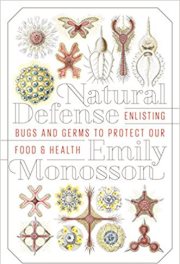Natural Defense: Enlisting bugs and germs to protect our food and health
 Emily Monosson
Emily Monosson
Island Press, £22.99
For the past 100 years, the world has relied heavily on chemicals to improve yields in agriculture, and antibiotics to cure human and animal infections. The pharmaceutical industry seemed to have a bright future and there is no doubt that mankind has benefited from the use of a huge number of chemicals. However, many pests and agents of disease have developed resistance by evolving new strains able to survive this chemical onslaught.
Emily Monosson describes ways of avoiding this dependence on chemicals – some old, some new. She talks about the importance of the microbiome around us and our food crops, and about how many microorganisms help prevent infection or damage. When we use chemicals and antibiotics, we often kill the beneficial organisms at the same time as the harmful ones.
The first part of the book deals with some of the newer forms of disease intervention, such as the use of bacteriophages and bacteriocins in place of antibiotics. The second part looks at the role of genetic modification and bioinformatics in the search for more targeted treatment of disease.
The essence of the book is that we need to understand the complex interaction between our bodies, and our crops, with the surrounding microbiome. Only then can we harness the beneficial microorganisms and target the harmful ones.
Dr Leighton Dann


